Organizational Development
Agile transformation: When can it make sense for companies?
The digitalization of our economy is leading to rapid changes in many business models and markets. As the speed of change in the environmental factors to which a company must respond increases, the call for flexibility, responsiveness and efficiency becomes ever greater. For this reason, many organizations are striving for agility in their ways of working. We can shape this with an Agile Transformation. The key principle is to start small, scale up slowly and improve continuously.
Contact us or make an appointment directly. We will be happy to answer your questions.
"Would you like to start your agile transformation or accelerate it with a breath of fresh air? Then let's talk and find out together what will help you."
What is an agile transformation?
Agile transformation: the term describes a change process in which the aim is to transform a company in the direction of agility. The target image here is an agile organization. In order to really achieve the benefits of an agile organization - such as better responsiveness, clear alignment of your organization to strategic goals, more productive and better collaboration among all stakeholders - a real change in corporate culture, organizational structures and the way of working is needed. In this regard, agile principles and agile approaches are already extremely effective in the process of transformation. This creates new thinking and action in your company. And you remain competitive even in fast, disruptive markets.
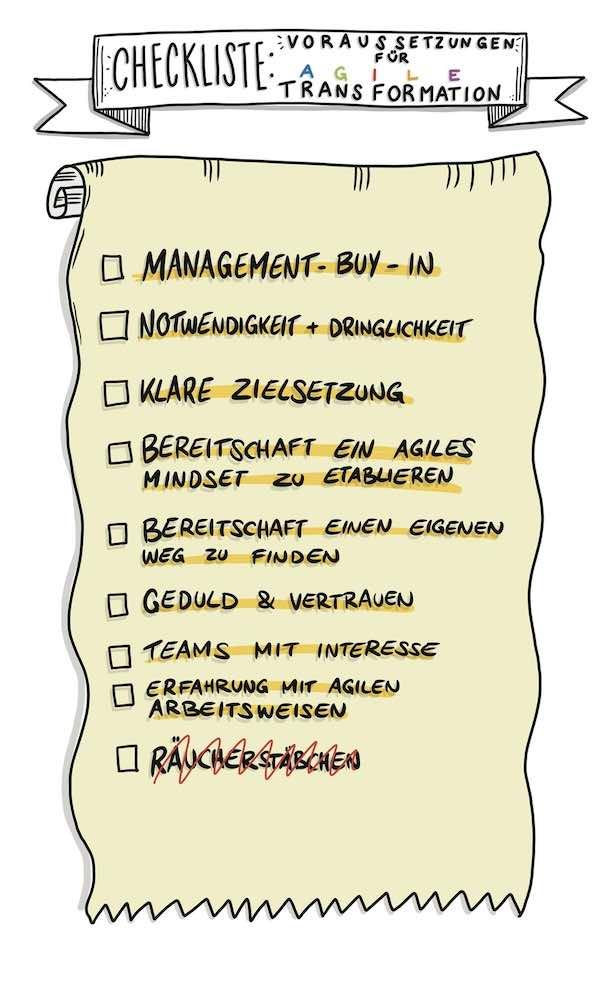
Is the organization ready for an Agile transformation?
There are a number of indicators that show whether an Agile transformation is easy to implement. These include the willingness of top management to go along with this development. It also requires - as with any major change - a need and urgency. This can answer the question, why should we change and why now. Likewise, a clear objective is needed. Agile transformation is not an end in itself. It is intended to achieve a goal. Typical goals are, for example, greater customer centricity and thus higher customer satisfaction, faster development cycles or greater flexibility in adapting to changing requirements.
There should be a willingness in the organization to establish an agile mindset and to find its own way in doing so. There are no blueprints that fit all organizations. But there are a number of patterns - in the form of frameworks - that can be used. Patience and trust are needed along the way, as some experiments have to be made and do not always lead to the goal immediately.
It is good if there is already interest and curiosity in some teams, this facilitates the start. It is important that people with experience in agile working methods are involved in the transformation. This saves time, as many obstacles can be avoided directly and undesirable developments can be identified early on. Contrary to some prejudices, the path to agility is characterized by esotericism or shishi, but by clear economic advantages.
What does agility mean?
Agility means establishing procedures and a mindset in an organization so that the following agile principles are implemented:
Delivering value to the customer: means that we focus on delivering value to the customer. On the one hand, this means asking what the customer wants. On the other hand, it means questioning whether our work steps contribute to this.
Getting work flowing: means avoiding waiting time as one of the biggest wastes. Typical means for this are pull systems and the visualization of work within workflows, e.g. with Kanban.
Empowerment and self-management: means that teams decide for themselves who does what and when. Decisions are not made top down, but team members hold each other accountable. Empowerment and self-management bring decisions as close as possible to the value-creating work in order to be responsive.
Transparency: means ensuring the self-management of teams by dealing openly with facts. This means that everyone has the same information basis for their work and can make informed decisions.
Inspect and adapt: means that knowledge is gained from experience and that decisions are made on the basis of observations. To this end, results and ways of working, i.e. both effectiveness and efficiency, are regularly checked for their value and - where necessary - adjusted. This fifth principle states that it is not enough to be merely reactive, but that it is necessary for us to actually react.
Agile Transformation Definition
Agile transformation is a transformation of an organization. An organization can be a division or a department of a company, but it can also be the entire company. The goal here is to move more in the direction of an agile organization. This means introducing agile ways of working, promoting an agile mindset and implementing a corresponding structure in the organization to support the goals.
Different agile patterns will be used for the implementation of agile approaches. From existing frameworks like Scrum, Kanban, Scrumban or Design Thinking on team level, or Scaled Agile Framework, Scrum@Scale or LeSS on multi-team level to a combination of patterns or elements, depending on the needs of the organization.
In agile transformation, it is important to observe agile principles as well as the success factors for change. Furthermore, it is essential to keep the goals and strategy of the organization in mind and to support them through the transformation.
The Agile transformation itself is also carried out using Agile methods. On the one hand, the change and the team driving it must lead by example. On the other hand, agile methods are a good practice for a change process, as the principles such as transparency, inspect and adapt, deliver value to the customer, etc. also ensure a successful change here.
Difference between transformation and change process
What is the difference between a transformation and a change process? Strictly speaking, a transformation is also a change process. The term change process is more general. It includes a change process that an organization goes through. This can be a "simple" change e.g. of a process, a tool or an alignment. Agile transformation is called transformation because it is a very comprehensive change that affects processes or collaboration as well as the culture level and the organizational structure.
Difference between Agile Transformation and Agile Transition
In fact, the terms Agile Transformation and Agile Transition are often used as synonyms. However, agile experts more frequently use the term agile transformation. A transition is often understood to mean a transition, e.g., into a new phase. In contrast, a transformation is used to describe a fundamental change. The transformation process affects so many aspects of an organization that the term transition falls short here for many.
Why agile working is becoming increasingly important for organizational development
In an increasing proportion of companies in our economy, agile working is taking hold, at least at the team level. More and more teams see advantages in using an agile method. Many areas of product development, where multiple teams are developing on a product, are also using agile approaches for cross-team coordination. This development simultaneously means that the need for agile knowledge in organizational development is becoming increasingly important.
When the introduction of agile methods becomes standard in more and more companies, the need for agile coaches also increases. At the same time, the need for organizational developers with agile knowledge and an agile mindset who can adequately accompany such a development is also increasing.
Project management is also an important element for organizational development itself. The activities that take place during the change process must be orchestrated. This is part of the basics of good change management. But even here, the challenges change quickly during the implementation of change due to various factors. These include, for example, a changing environment or a changing business model.
Therefore, agile methods are not only helpful but also necessary here. Thus, the transformation team that drives an agile transformation is not only a good role model, but can also easily absorb and deal with the changes in the framework conditions and new needs of the organization during the change process.
Advantages
Business: a more agile organization leads to more speed in the development and delivery of products or services. Decisions are made more decentrally, where the expertise lies. This leads to faster decision-making speed at all levels.
Executives: the executive in the agile organization is relieved. The decisions for different aspects are distributed on different shoulders through separation of powers. This allows a leader to focus on his or her own role and excel there.
Employees: the majority of employees are more satisfied in an agile organization. They see their own value contribution more clearly and have more influence on decisions at their level of competence.
Culture level: the work culture is that of the agile mindset. This means that there is a culture of transparency and open error culture that inspires continuous improvement in the organization. This culture appeals to most of the company's employees significantly more than the more traditional culture.
Continuous improvement: with agile processes and an agile culture comes continuous improvement of workflows, structures, and products.
Disadvantages
Business: a comprehensive transformation leads to long-established processes and familiar structures being changed or replaced. In the first step, this can lead to new challenges and unfamiliar results.
Managers: there are managers who act in a hero mode in traditional companies. They take all the responsibility on themselves, take care of their employees and defend their areas. They often play an important role in the companies. For these leaders, it can be a difficult transformation process. Letting go hurts. But that's what change will demand of them.
Employees: there are employees who do not want to determine much themselves. They prefer someone else to take responsibility and dictate what needs to be done. They may lose these employees, they may look for an employer where more traditional processes are followed.
Culture level: the transformation will lead to a change in corporate culture. There are two challenges here. First, traditional culture and mindset really need to be let go, otherwise culture will remain an obstacle in the journey. This often leads to dissatisfaction among employees, as the corporate culture then contradicts the desired way of working in many. On the other hand, however, culture must not become a "everyone gets to do everything." At least in large companies, there must still be a way to ensure rule compliance/governance, for example. This partly requires rethinking and reinterpreting, and that is usually a challenge.
What is the goal of an Agile Transformation
Organizations start an Agile Transformation when they want to become more "agile". As a rule, the goal is to become an agile organization. However, this is only a means to an end. The primary goal of organizations that start an Agile Transformation is to increase their adaptability, implement a stronger customer orientation and thus achieve a competitive advantage in their market.
The Agile transformation in the organization often starts before it is "officially" launched, with individual project teams beginning to use agile methods such as Scrum. They then have good experiences with it, the customer is more involved and is more satisfied, and the teams gradually increase their quality. These are successes that first become visible on a small level and are then to be extended to the entire organization with the official Agile Transformation.
Agile transformation explained with an example
The Agile transformation at one of our large customers started in the management circle. The company has over 1000 employees and manufactures a wide range of electrotechnical products. In the past, the development of a product and corporate strategy was often outsourced to consultancies. Now the top management circle wanted to develop the strategy themselves and use an agile approach for it. We started with workshops that first provided a baseline of agile principles and practices, and then worked together to create a Kanban board for the strategic initiatives that would be put to the test. In regular work sessions, the management circle then proposed initiatives, tested them, tried them out, and either discarded them or included them in the portfolio, or more precisely in the portfolio kanban board.
The process of agile strategy development that we went through in this way, which lasted several months, promoted an agile mindset in the management circle involved and made it possible to experience it. This excited a number of managers so much that they began to integrate agile practices into their daily lives on their own. The next step was to require their teams to try out agile practices. This started the penetration of agile methods in the organization.
The actual step toward an "official" transformation began after the first teams saw and reported success. For this, a central interdisciplinary team was set up to guide the orchestration of the transformation. This team set up a process for teams to sign up for agile coaching, and how this coaching would guide them through their own transformation at the team level.
In the meantime, the organization not only has its own product ideas under control and is equipped for future developments, but the time-to-market speed has also increased significantly. These successes also led to an acceleration of the transformation itself.
Agile transformation roadmap
Before an Agile transformation starts, several teams in the organization have usually already tried out agile methods. This is what we call "agility on one's own initiative" here.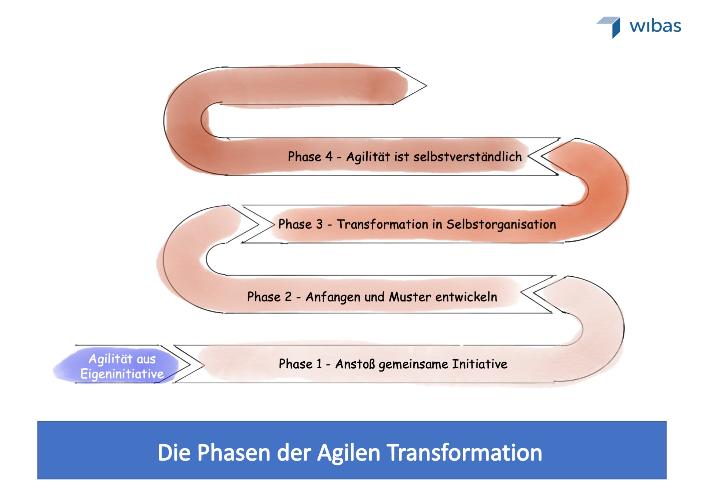
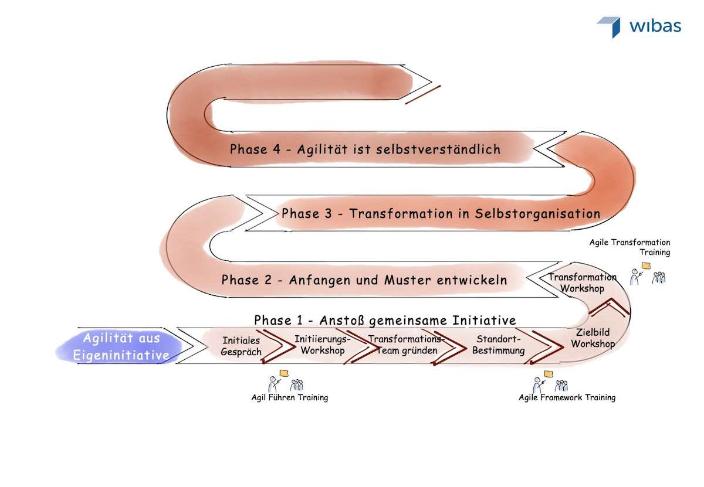
First phase: kick-off joint initiative
If the "official" Agile transformation then begins, a joint kick-off of the initiative takes place in a few small steps that ensure that the initiative is known, the goal is known, the first stakeholders are taken along and the next phase is prepared.Second phase: Start and develop patterns
In the second phase, several activities on different levels and in different teams start in parallel. In this phase, the goal is to find and try out suitable patterns, procedures and frameworks for the organization. If necessary, the steps are accompanied by various training measures.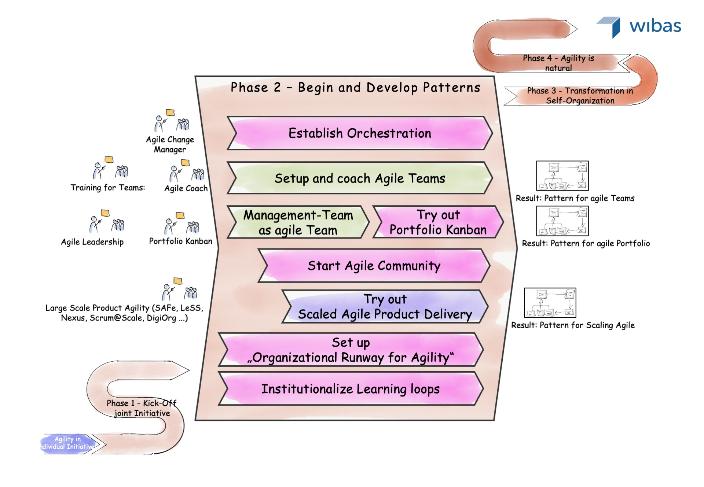
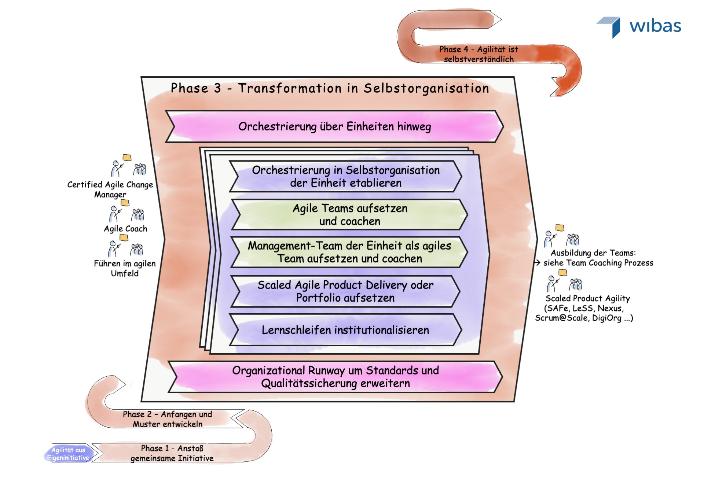
Third phase: Transformation into self-organization
In the third phase, the goal is to continue the activities, to carry them out more broadly, and to let this be driven by various organizational units themselves. The central orchestration decreases and only provides the framework and continues to support the organizational runway - i.e., the creation of the conditions for agility within the organization. This includes, for example, finding new setup structures where necessary or helpful.Fourth phase: Agility is natural
In the fourth phase, the organization reaches the point where agility is taken for granted. Here, it is especially important to bring the late majority along and continue to break down barriers. In this phase, the organization then remains and continues to develop as an organization, including the cultural level.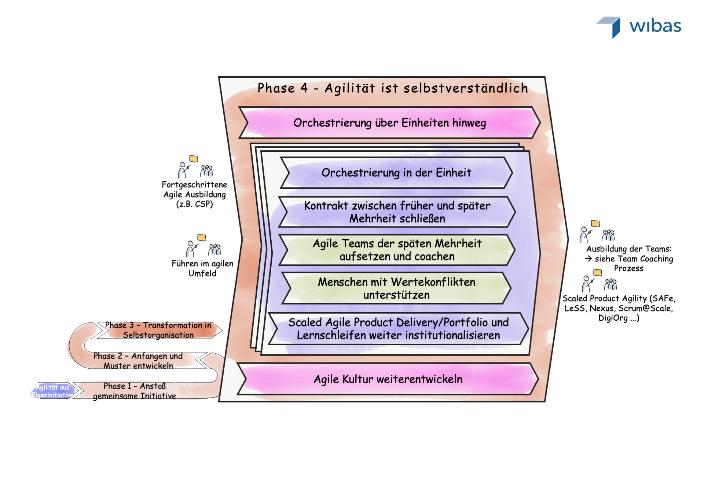
Success factors and framework conditions
The following success factors make for an easier and smoother transformation.
Top management should understand agility (basic knowledge)
As already indicated in our example, a fundamental agile understanding of top management provides the necessary support during the transformation. Management creates the environment and the framework for the change or transformation. Doing the right thing in leadership that supports the transformation is a challenge that top management should be equipped to meet. Here, an understanding of agile principles is an essential asset.
Does everyone have to participate?
The easy answer: no. A sensible approach should be taken based on the adoption curve of change. That means start with volunteers, start with pilot teams, and start with pilot areas that feel like it. People who are opposed to the change will always find reasons why it won't work. People who are for the change will find a way to make it work. And that creates success stories that in turn convince others.
Organizational Development / Change Management
Good practices from change management are also important in an Agile transformation. Likewise, a change management team - that is, a central team that orchestrates the change - becomes important.
Develop vision / idea of the target state
As with other changes, a common goal and vision is necessary. With this, there is also a shared understanding of why the organization needs to change and where it is going.
Agile principles
Many patterns, frameworks and approaches can be used in an agile transformation. It is important that these implement the agile principles already described above:
-
Deliver value to the customer
-
Bringing work into flow
-
Empowerment and self-management
-
Transparency
-
Inspect and adjust
Agile mindset
As already described, a fundamental basis for agility is the (further) development of an agile mindset. Only with a working culture that is characterized by
-
Transparency,
-
Respect,
-
open error culture,
-
the willingness to assume responsibility (at all levels),
-
a focus on customer needs and delivery to customers, and
-
Learning loops to continuously improve both deliveries/products and ways of working
an Agile transformation has a chance.
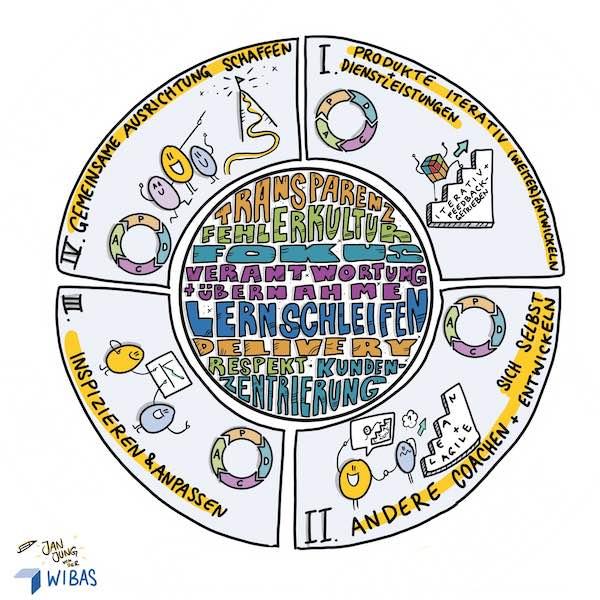
Agile Transformation Coach
An essential success factor of an agile transformation is the support of agile coaches who have internalized the agile mindset. An experienced agile coach knows typical obstacles and resistances, but also quickly recognizes specific obstacles of the organization - including cultural ones - and is an important guide in the transformation.
In addition, an experienced agile coach has also been through a number of agile transformations and bring good practices to the various aspects of the transformation.
Contact us or make an appointment directly. We are Timo Foegen, Yvonne Fischer, Tina Eisoldt, Daniel Votta and Lutz Koch.
"Are you undertaking a transformation and looking for coaching support for it? Then let's talk."
Agile Coach Training
An organization striving for an agile transformation needs agile coaches to support and guide the organization. In order to carry out a targeted development of employees into agile coaches, a Agile Coach Training an. The prerequisite for participation in such training is some experience in agile working and with the agile mindset.
In the training, the various aspects of being a coach are made explicit in several modules, backed up with theory and practiced. Participants also learn a number of different techniques and tools that they can use as an agile coach. At the end of the training, participants are ready to support an Agile transformation in a targeted way.
Change management
Transformation is a change in working methods and culture. Sustainable change management is essential for such a change. By adhering to change management principles, employees are taken along and obstacles are removed or a way of dealing with them is found. An important aspect here - as already mentioned - is implementation along the adoption curve and the involvement of voluntary pilot teams. With them, the new way of working together can easily be tried out and made successful.
Agile Transformation Consulting
As an agile consultancy, wibas specializes in supporting agile transformations. Our agile coaches have a wealth of experience with successful transformations that they can use successfully for their organization. With our Agile Transformation Consulting they can shape an efficient and effective transformation.
Determine the maturity level of an Agile Transformation
The pros and cons of agile maturity measurement are always a popular topic of discussion. In fact, there is often a discrepancy between "we are already agile, we do Scrum" and an actual agile mindset. Often, just following an agile framework is equated with agility. In doing so, the question of the underlying goal is forgotten. Why do we want to be more agile, what is the goal? And have we achieved the goal?
Furthermore, people who have actually internalized an agile mindset will never say "we are agile". They will always say, we still have a way to go and can still get better.
To officially launch an agile transformation, it can be useful to take a closer look at the "agile maturity level". This may focus on assessing the organization's ways of working for the benefits that agile can bring. Likewise, the focus can be on reviewing teams that are "already agile" to see if they are achieving their goals. Both of these help to develop the way forward for the transformation of this specific organization and to get started.
Conclusion
Agile transformation leads to a better adaptability of the organization to the conditions in its market or environment. This is an advantage for almost every organization, almost regardless of the industry. For this reason, many organizations are on exactly this path and have started such a transformation in recent years.
In some of the organizations it leads to the desired benefits. In some cases, unfortunately, either politically motivated behavior within the organization, an incomplete understanding of agile, or a lack of experienced agile coaches leads to adoption and pure adherence to frameworks, but not to organizational transformation. In these cases, the goal sought through agile is also not achieved. Then the frameworks are often blamed and they are "burned" in the organization.
Therefore, it is important: if an organization wants to start or re-start an agile transformation, it should be done properly. The success factors must be taken into account, otherwise the transformation will make a lot of work, but will not lead to the goal.
Certified Agile Coach
Accompany your company safely in the agile transformation. In our training, you will learn everything that is important for this.
Organization in a Digital Age
As a leader, are you wondering how organizations can be more responsive and faster in a digital age? Our book provides answers.
Agility Compact
Agile makes use of many frameworks and techniques. This book will help you make the right choice for you.
Map of Change
Start your journey to agile transformation now.
Your expert for Agile Transformation:
Malte Foegen
